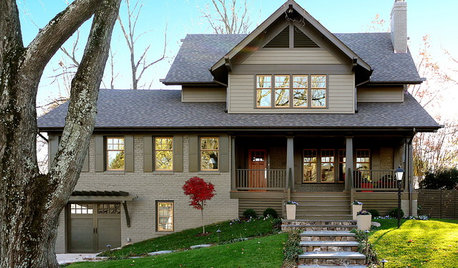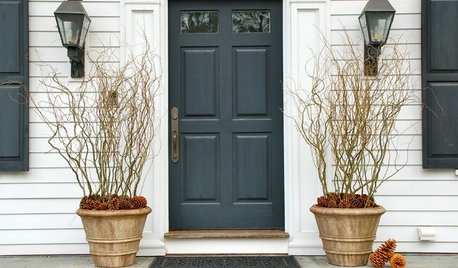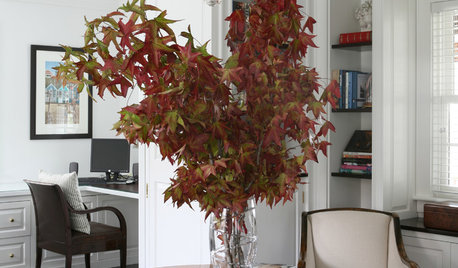Red Maple leaves and branches turning black and dying
fenix
14 years ago
Featured Answer
Sort by:Oldest
Comments (31)
brandon7 TN_zone7
14 years agofenix
14 years agoRelated Discussions
What is causing my red maple branch tips to die?
Comments (2)Thank you, bboy. As it turns out, we did visit a local nursery with a Master Gardener on the premises and he was able to identify the problem. Turns out what everyone else (including several people in nurseries) thought was the dried up remains of a pest, was effluence. The MG speculated that the tips dying back was due to bacterial blight, and the tree's response was to weep sap out just at the spot where deadwood met live wood. He said all maples have such high sugar content in the sap that when it oozes out and subsequently dries it looks white and hardened, like that on my branches....See MoreOctober Glory Maples leaves dying
Comments (9)Attached a picture of leaves close up for nurseryman33. toronado3800-never even thought of the different soil type and digging times. Yes, they are right heights. The University of Kentucky suggested I have "Anthracnose Disease". Too much water. But, this has not effected the Red Sunset Maples..... THANK YOU for responding. My searches are not finding the problem/solution.......See MoreJapanese Maple Leaves turned black and dropped
Comments (3)Because of the timing and circumstances surrounding this planting, I'd be very hesitant to immediately assume it was some sort of disease issue. We are more likely looking at transplant shock and an early dormancy, which can often be triggered by planting late in the season. Excessive rainfall during this period could certainly account for what you describe as well. Retaining dried, dead foliage is pretty common for this selection also. As long as the container is filled with a high quality, fast draining potting soil and offers adequate drainage, I'd wait until spring to see how these trees bud out before I'd do any thing else. They will probably be just fine....See MoreNew roses branches turning black.
Comments (6)ok caflowerluver... How are the Austin roses doing? Thanks! I just noticed you been growing roses for a long while! Awesome! Yes if this happened to me I'd be wondering too because this is not your normal situation for sure... I have 4 of the same type mini grocery store roses planted in different locations and last October all there canes started turning black and they look dead right now. All 4 plants... Since I did not fertilize and they are in different locations I'm baffled...lol...See Morebrandon7 TN_zone7
14 years agofenix
14 years agorhizo_1 (North AL) zone 7
14 years agojean001
14 years agobrandon7 TN_zone7
14 years agofenix
14 years agobrandon7 TN_zone7
14 years agobrandon7 TN_zone7
14 years agotree_oracle
14 years agofenix
14 years agoDan _Staley (5b Sunset 2B AHS 7)
14 years agoken_adrian Adrian MI cold Z5
14 years agobrandon7 TN_zone7
14 years agoken_adrian Adrian MI cold Z5
14 years agotree_oracle
14 years agojean001
14 years agotree_oracle
14 years agonandina
14 years agojean001
14 years agopetzold6596
14 years agofenix
14 years agopetzold6596
14 years agobrandon7 TN_zone7
14 years agopetzold6596
14 years agotree_oracle
14 years agoken_adrian Adrian MI cold Z5
14 years agoDan _Staley (5b Sunset 2B AHS 7)
14 years agobrandon7 TN_zone7
14 years ago
Related Stories

TREES11 Japanese Maples for Breathtaking Color and Form
With such a wide range to choose from, there’s a beautiful Japanese maple to suit almost any setting
Full Story
REMODELING GUIDESHouzz Tour: Turning a ’50s Ranch Into a Craftsman Bungalow
With a new second story and remodeled rooms, this Maryland home has plenty of space for family and friends
Full Story
WINTER GARDENINGBranches Bring the Winter Spirit to Container Gardens
Add dimension and drama to winter pots with branches from austere to downright colorful
Full Story
DECORATING GUIDESRoom of the Day: Black, White and Red All Over
Custom fabric, heirlooms, bold color and a beloved collection of books cozy up this farmhouse library
Full Story
HOUZZ TOURSMy Houzz: Red and Black Pop in a German Penthouse
See how an eye-catching color scheme, international finds and understated charm raise the style factor in this decorator's home
Full Story
GARDENING GUIDES12 Japanese Maples for a Sunny Garden
The right maple in the right place shines in hot summer sun
Full Story
DECORATING GUIDES9 Easy Ways to Decorate With Autumn Leaves
Give your home a burst of color that can be used Halloween through Thanksgiving
Full Story
FALL GARDENING5 Ways to Put Fall Leaves to Work in Your Garden
Improve your soil and yard the organic way with a valuable garden booster that grows on trees
Full Story
LAUNDRY ROOMSRoom of the Day: The Laundry Room No One Wants to Leave
The Hardworking Home: Ocean views, vaulted ceilings and extensive counter and storage space make this hub a joy to work in
Full Story
HOME TECHTurn 'Obsolete' Tech Into Fun Home Help
Here's how to put your old Mac, Atari or Newton to work around the house
Full Story




ken_adrian Adrian MI cold Z5